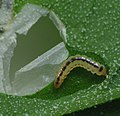| Chrysoesthia sexguttella | |
|---|---|
 | |
| | |
| Scientific classification | |
| Domain: | Eukaryota |
| Kingdom: | Animalia |
| Phylum: | Arthropoda |
| Class: | Insecta |
| Order: | Lepidoptera |
| Family: | Gelechiidae |
| Genus: | Chrysoesthia |
| Species: | C. sexguttella |
| Binomial name | |
| Chrysoesthia sexguttella (Thunberg, 1794) | |
| Synonyms | |
| |
Chrysoesthia sexguttella, the orache leafminer moth, is a moth in the family Gelechiidae. It is found in all of Europe, east to southern Siberia, [1] as well as the north-eastern parts of North America, where it might be an introduced species.
Contents
The wingspan is 8–10 mm. The head is metallic brassy-grey. Forewings are dark purplish-grey, mixed with black, with some whitish scales; a yellow subdorsal spot in the middle, and a smaller one in disc posteriorly; an ill-defined ochreous-white tornal spot, and another on costa at 3/4. Hindwings are grey. The larva is yellow-whitish; dorsal line brownish; lateral line of orange -reddish spots; head pale brown; plate of 2 blackish. [2] [3] [4] [5]
Adults are on the wing from May to June, and again from August to September. There are two generations per year.
The larvae mine the leaves of Atriplex species (including Atriplex cakotheca , Atriplex hastata , Atriplex hortensis , Atriplex littoralis , Atriplex prostrata , Atriplex nitens , Atriplex patula and Atriplex sibirica ), Chenopodium species (including Chenopodium album , Chenopodium bonus-henricus , Chenopodium giganteum , Chenopodium glaucum , Chenopodium hybridum , Chenopodium murale , Chenopodium opulifolium , Chenopodium polyspermum , Chenopodium quinoa , Chenopodium urbicum and Chenopodium vulvaria ), Amaranthus blitum , Amaranthus caudatus , Bassia scoparia and Spinacia . They form a contorted gallery on the surface of the leaves.


